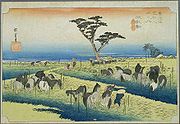
Chiryu-juku
Encyclopedia

53 Stations of the Tokaido
The are the rest areas along the Tōkaidō, which was a coastal route that ran from Nihonbashi in Edo to Sanjō Ōhashi in Kyoto.-Stations of the Tōkaidō:...
of the Tōkaidō
Tokaido (road)
The ' was the most important of the Five Routes of the Edo period, connecting Edo to Kyoto in Japan. Unlike the inland and less heavily travelled Nakasendō, the Tōkaidō travelled along the sea coast of eastern Honshū, hence the route's name....
. It is located in the present-day city of Chiryū
Chiryu, Aichi
is a city located in central Aichi Prefecture, Japan. As of October 2011, the city had an estimated population of 69,127 and a population density of 4230 persons per km². The total area was 16.34 km².-Neighboring municipalities:*Toyota*Kariya* Anjō...
in Aichi Prefecture
Aichi Prefecture
is a prefecture of Japan located in the Chūbu region. The region of Aichi is also known as the Tōkai region. The capital is Nagoya. It is the focus of the Chūkyō Metropolitan Area.- History :...
, Japan
Japan
Japan is an island nation in East Asia. Located in the Pacific Ocean, it lies to the east of the Sea of Japan, China, North Korea, South Korea and Russia, stretching from the Sea of Okhotsk in the north to the East China Sea and Taiwan in the south...
. It was the westernmost post town
Shukuba
were post stations during the Edo period in Japan, generally located on one of the Edo Five Routes or one of its sub-routes. They were also called shukueki . These post stations were places where travelers could rest on their journey around the nation...
in Mikawa Province
Mikawa Province
is an old province in the area that today forms the eastern half of Aichi Prefecture. It was sometimes called . Mikawa bordered on Owari, Mino, Shinano, and Tōtōmi Provinces....
, and was 330 kilometres (205.1 mi) from Nihonbashi
Nihonbashi
, or Nihombashi, is a business district of Chūō, Tokyo, Japan which grew up around the bridge of the same name which has linked two sides of the Nihonbashi River at this site since the 17th century. The first wooden bridge was completed in 1603, and the current bridge made of stone dates from 1911...
, the start of the Tōkaidō, so it took approximately 10 days to for average travellers to reach.
History
Chiryū-juku was noted for a famed Shinto shrine, the Chiryū Daimyōjin, and also for its flourishing horse market, held in late April to early May of each year. Tokugawa IeyasuTokugawa Ieyasu
was the founder and first shogun of the Tokugawa shogunate of Japan , which ruled from the Battle of Sekigahara in 1600 until the Meiji Restoration in 1868. Ieyasu seized power in 1600, received appointment as shogun in 1603, abdicated from office in 1605, but...
ordered that the post station plant pine trees
Japanese Red Pine
The Japanese Red Pine has a home range that includes Japan, Korea, northeastern China and the extreme southeast of Russia . This pine has become a popular ornamental and has several cultivars, but in the winter it becomes yellowish. The height of this tree is 20–35 m...
along through route of the highway before and after the town. The classic ukiyoe print by Ando Hiroshige (Hoeido edition) from 1831 to 1834 depicts horses, and also one of the pine trees. Hiroshige entitled the work . Despite the construction of railroads following the Meiji restoration
Meiji Restoration
The , also known as the Meiji Ishin, Revolution, Reform or Renewal, was a chain of events that restored imperial rule to Japan in 1868...
the horse market continued into the Showa period
Showa period
The , or Shōwa era, is the period of Japanese history corresponding to the reign of the Shōwa Emperor, Hirohito, from December 25, 1926 through January 7, 1989.The Shōwa period was longer than the reign of any previous Japanese emperor...
, and most of the pine trees survived until the 1959 Isewan Typhoon
Typhoon Vera
Super Typhoon Vera was the strongest typhoon to hit Japan in recorded history. With winds of 160 mph, Vera slammed into the southeastern coast of Japan in Wakayama Prefecture and then proceeded northeast across Honshū, causing widespread damage and flooding. 5,098 people were killed in Japan...
.
Further reading
- Carey, Patrick. Rediscovering the Old Tokaido:In the Footsteps of Hiroshige. Global Books UK (2000). ISBN 1901903109
- Chiba, Reiko. Hiroshige's Tokaido in Prints and Poetry. Tuttle. (1982) ISBN 0804802467
- Taganau, Jilly. The Tokaido Road: Travelling and Representation in Edo and Meiji Japan. RoutledgeCurzon (2004). ISBN 0415310911

